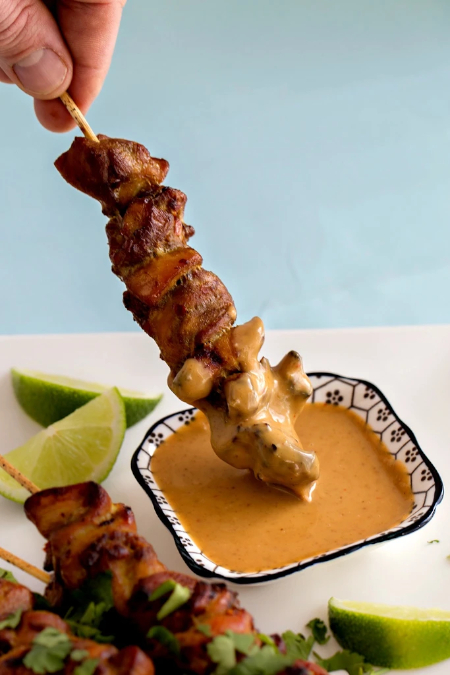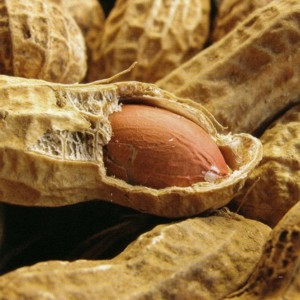Yesterday, I promised to provide some classic peanut recipes from around the world. I was surprised to discover all the different cultures and cuisines that use peanuts. Because there were so many, I had to chose a few representative, classic dishes from each… Some are sauces and condiments you can use in conjunction with any number of dishes.
 But first, a little history…
But first, a little history…
Peanuts have been harvested and used for food for literally thousands of years. They’re treated with great respect in Asian, Indian, Southeast Asian, Middle Eastern, African, South American and North American cuisine.
Peanut butter – from ancient versions, hand-ground in primitive mortars and pestles, to contemporary supermarket brands – has been known and cherished as the base for myriad savoury sauces just about everywhere.
The US National Center for Biotechnololgy Information website provides in-depth info on the origins of the peanut:
“The history of peanuts dates back to the times of the ancient Incas of Peru. They were the first to cultivate wild peanuts and offered them to the sun God as part of their religious ceremonials. […] The modern history of peanut popularization began with the civil war of the 1860s in America. George Washington Carver who is known as the ‘father of the peanut industry’. […] He developed more than three hundred products derived from the peanut.”
Some of our older readers may remember the contribution former US President Jimmy Carter made to the peanut industry while he built his family peanut empire, almost single-handedly establishing Georgia as the Peanut Capital of America.
“Peanut butter [as we know it today] was created in the 1890s […] as a soft protein substitute for people with poor teeth. In 1895, Dr. John Harvey Kellogg patented a, ‘A Process of Preparing Nt Meal’,” to be used in food processing.
“The first process for roasting shelled peanuts in oil was developed in the early 1900s and the first long-shelf-life version of that product was marketed in airtight bags under the ‘Planters’ label.”
…And a few amazing facts
The National Peanut Board shares 25 Fun Facts About Peanuts, from which I’ve selected a few favourites:
- It takes about 540 peanuts to make a 12-ounce jar of peanut butter.
- By law, any product labeled “peanut butter” in the United States must be at least 90 percent peanuts.
- It takes 3.2 gallons of water to [grow] 1 ounce of peanuts. (Bonus fact: 1 ounce of almonds takes 28.7 gallons)
- Astronaut Alan Shepard brought a peanut with him to the moon. (Read about making a PB&J on the International Space Station.)
- Women and children prefer creamy peanut butter, while most men opt for chunky.
- The average European eats less than 1 tbsp of peanut butter a year.
- There are four different types of commercially employed peanuts – Runner, Valencia, Spanish and Virginia…
- …But there are thousands of cultivars of peanuts used locally and by home cooks around the world.
- One acre of Georgia farmland can produce enough peanuts to make to make 35,000 PB&J sandwiches.
Why are peanuts so special?
Even the earliest users of the so-called ‘ground nut’ knew how healthful and nutritious it is. The Peanut Institute in Albany, Georgia, tell us there’s really nothing not to like about its signature product:
- 7 g of protein
- 19 vitamins and minerals
- 0 cholesterol or gluten
- Heart-healthy fats
- Fiber
In addition, peanuts have been found to contain recently discovered beneficial compounds including flavonoids, resveratrol, Q10 and antioxidants.
Some choice dishes…
India
Eggplant with Peanut Masala: A classic Southern Indian vegetarian dish. Use only the smallest ‘baby’ eggplants for best results.
South Indian Peanut Rice: A great savoury accompaniment to light veggie, chicken and lamb curries.
Indian Peanut Stew: It’s everywhere. Brown rice, veggies, garlic, peanuts, ginger and cayenne. Multiple dimensions of crunchiness in a thick, flavourful sauce.
Spicy Peanut Chaat: Peanut and veggie salad. It’s vegan, spicy, tangy and crunchy. And takes all of about 5 minutes to prepare!
Asia
Kung Pao Chicken: Maybe the bet-known Asian Peanut dish. Can be made with Chicken, Tofu or Mushrooms.
Bang Bang Chicken: A luscious combination of Poached Chicken and jullienned veggies. Served over rice with a peanut, soy sauce, sesame oil and Szechuan peppercorn dressing.
Dan Dan Noodles: A bold, spicy recipe using chili oil, Szechuan peppercorns, garlic and five-spice powder. You can get the Sui Mi Ya Cai dried veggie flakes at just about any Asian grocery. Leave them out if you wish. And streamline the recipe by using prepared chili oil. The recipe looks amazingly complex, but it really isn’t!
Lajiang Mian (AKA – Doubanjiang Mian): Shanghai Hot Sauce Noodles.
Southeast Asia
Pad Thai: A spicy/sweet stir fry dish made with rice noodles and shrimp, chicken, or tofu. The sauce features peanuts and tamarind. Stir in crumbles of scrambled egg, or top with a fried egg in classic Thai style.
Thai Beef Curry: A rich, spicy curry with chopped peanuts, Thai Red Curry Paste, coconut milk and lemongrass.
Gado Gado: A roasted potato salad with green beans, served warm, with a coconut-peanut dressing.
Beef Satay: A signature Malaysian/Indonesian dish featuring Indonesian Sweet Soy Sauce.
Chicken Satay: The ‘other’ Satay, from Penninsular Maylasia. (See photo, above left) A light, spicy golden sauce, quite different from the dark Satay used with Beef. Except for the peanuts!
Middle east
Peanut Butter Hummus: A ‘nouveau’ version of a Middle Eastern staple. Replace all or part of the Tahini with smooth peanut butter.
Falafel with Peanut Sauce: Classic Falafel. Made from Chickpeas, but you can substitute some of the chick peas with ground peanuts. The Peanut Sauce is a Middle Eastern legend. Skip the Halloumi Cheese if you want to simplify prep.
Dukkah: The universal Middle Eastern spice blend. Mainly composed of roasted sesame seeds, crushed peanuts, cumin, and coriander. All ground up medium-fine; not powdery.
Africa
African Peanut Soup: Also known as ‘Stew’ in some places. This is a classic and staple, found in both western and eastern Sub-Sahara Africa. . It has many variants from region to region. But all contain peanuts, chickpeas, onions, garlic and spices.
Mafé: Senegalese Peanut Stew: Traditional preparation that goes back to tribal times. It’s part of a family of similar found across West Africa.
Lamb with Spicy Peanut Sauce: A West African original. It’s traditionally VERY hot. You may want to adjust the spice to your taste!
South America
Sopa de Mani: A creamy, rich Bolivian peanut soup traditionally made with chicken or beef. Resplendent with a dozen different veggies, garlic and cumin, and garnished with fresh cilantro. Served with crusty bread.
South American Peanut Pork: A staple. Can also be made with chicken. Flavoured with cumin, paprika, cayenne and lots of garlic. Pre-cooked rice is folded into the primary ‘stew’.
Aje De Mani: Colombian Peanut Sauce. Goes with almost anything!
North America
Hey! Do I really have to showcase any specific North American peanut dishes? You probably already know better than I do what you and your family love!
Join the majority!
Make peanuts a bigger part of your diet. More than half the world’s cooks can’t be wrong!
~ Maggie J.

